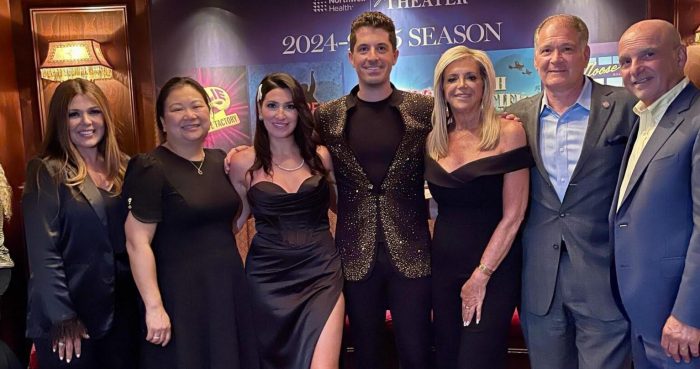By Julianne Mosher
Get your pink blazer on and swipe on some lip gloss for the John W. Engeman theater in Northport’s latest production of Legally Blonde The Musical.
Based on the 2001 hit movie starring Reese Witherspoon, the 2007 Broadway musical, written by Heather Hach, hints to a lot of the famous movie moments and quotes, but certainly has its own identity and it’s just as good as the famous 00’s comedy.
But it couldn’t have gained the standing ovation it received on the theater’s opening night if it weren’t for the talented cast and crew who took on quite a challenge with Jay Gamboa’s choreography and direction from Trey Compton.
The show starts out with a simple stage design, headed by Kyle Dixon, of a Delta Nu doorframe at Elle Woods’ (Emma Flynn Bespolka) UCLA sorority house. There, we meet her best friends and sorority sisters, Margot (Lara Hayhurst), Serena (Juliana Lamia) and Pilar (Bridgette Carey) who are writing out a congratulations card for Elle who thinks she’s getting engaged to her boyfriend, Warner Huntington III (Nathan Haltiwanger).
The girls, dressed in their best 2000s-styled clothes (low rise jeans, a lot of color and bedazzles) learn from Elle’s dog, Bruiser, (Little Ricky and Cha Cha), that the soon-to-be bride is at the mall finding the most perfect dress. Always on cue with his scripted barks, jumps and licks, Bruiser with his minimal appearances had the audience in awe at what a good boy he is under the stage lights.
After finding the perfect outfit, hair done and makeup on, Elle meets Warner at a restaurant where he tells her he wants to get serious with her … Down on one knee he takes her hand and much to her surprise and dismay breaks up with her. Afterall, he’s going to law school to kickstart his political career and he needs “a Jackie, not a Marilyn.”
Two weeks of mourning of her idea of marriage falling apart, Elle decides to follow Warner to Harvard Law School. Although she has a degree in fashion merchandising from UCLA, with the financial help of her wealthy parents (Emily Bacino Althaus and Matt DeNoto), and a fantastic cheerleading-inspired live dance performance at Harvard clad in glitter and pink, she (shockingly) gets in and heads to the east coast. What, like it’s hard?
At Harvard, she introduces herself to her classmates, Emmett (Quinn Corcoran), Aaron (Christian Melhuish), Sundeep (Yash Ramanujam) and Enid (Haley Izurieta), as a Gemini who once told Beyonce that orange is definitely not the new pink. Everyone except for Emmett doesn’t take her seriously and backs away, heading to the tough Professor Callahan’s class (James D Sasser) where Elle learns Warner is dating a true “Jackie,” Vivienne Kensington (Nicole Fragala).
Throughout the rest of Act I, we see Elle struggle with acceptance as she tries to bring her sunny California personality to the gloomy New England university, while also trying to woo her ex back into her life (and dealing with his judgmental and jealous new girlfriend). The musical brings the iconic scene from the screen when Vivienne and her friends invite Elle to a costume party – but it’s not – and she learns that the hard way as she shows up as a Playboy Bunny.
Luckily for Elle, we meet her new best friend who becomes her support system, Paulette (Chanel Edwards-Frédérick), a hair dresser with a sad backstory. Paulette gushes over the new UPS driver, Kyle (Jeffrey Keller), who doesn’t have a lot of lines, but you’ll laugh until your stomach hurts at his seductive walk through the theater and suggestive jokes that have all the girls (and guys) in the beauty salon swoon. Eventually Paulette wins him over by the 99.99 percent effective “bend and snap.”
Back in Elle’s life, she gets added to Professor Callahan’s legal team to represent a former Delta Nu workout superstar, Brooke Wyndham (Julianne Roberts), who is accused of killing her husband. We’re introduced to her in Act II at the woman’s prison where she is demonstrating what is probably the most intense choreography the audience has ever witnessed – a whole song and dance involving constant jump roping. Roberts, with her impeccable lungs, doesn’t miss a beat and double jump with no flaws in her vocal range receiving a long-winded applause when the number is over. You’ll be tired watching her.
From now on, we’re in court learning about Brooke’s story and who might have actually killed her husband. Using her knowledge of all thing’s beauty, Elle wins the case because everyone knows that you don’t take a shower after a perm…
This show is the most fun you’ll have and with a large cast of 25 talented actors (and two talented pups), you’ll always see something new. The lead role of Elle couldn’t have been better picked as Bespolka truly embodies the character in every sense. In fact, even the ensemble who appeared in only one or two numbers continuously also stole the show.
So, don’t object to this great opportunity and see for yourself what a great play this is.
The John W. Engeman Theater, 250 Main St., Northport presents Legally Blonde The Musical through August 25. The Main Stage season continues with the murder mystery Clue from Sept. 12 to Oct. 27. Tickets range from $80 to $95. To order, call 631-261-2900 or visit www.engemantheater.com.






















